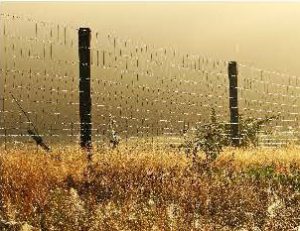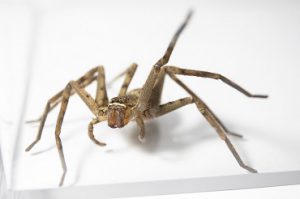The Other Florida Residents
Generally, Florida residents are pretty hardy souls. For instance, early settlers required a healthy fear of bears. Florida Black Bears lived throughout the state at that time and were of great concern for anyone going out at night to use the privy. Though some few Florida black bears are still around, most of us will never see one in the wild.
Panthers, Bears, & Arachnids, Oh My!

When we moved into our first Florida home, I discovered a new fiend for my phobic nightmares: the Huntsman spider, Heteropoda venatoria. This very large arachnid is sometimes called a “Housekeeper-” or giant crab spider. Huntsman spiders start out small, as tiny spiderlings, and may grow to five inches from leg tip to opposite leg tip. They can often be seen on a wall with their legs spread out in a circle like the spokes of a wheel or in a corner with the four legs from each side pulled together into a line.
These arachnids do not spin a web and stay in one place like a well-behaved house spider. Instead, as their name suggests, they wander and hunt for their food, usually at night. You may sometimes walk through a tough single strand of web either in the yard or in the home. This is the Huntsman’s rappel line, used to get from one spot to another quickly, like Spiderman.
Today our fears tend toward the irrational type. And arachnophobia, or fear of spiders is one example. Seasoned Florida residents get used to the occasional wild trespasser in our home. And, excluding bears and alligators, the accidental visitor is usually much smaller than a human. But what can you do if you are so terrified of wild things that it causes irrational fear, affecting your sleep and sense of well-being?
Desensitize yourself
By repeatedly exposing oneself to photos of fear-inducing creatures, slowly increasing ones’ exposure times in increments, one can become desensitized to the sight of them. This really did work for me. I had lived in Florida for more than 10 years when I began helping my children learn about our beautiful state and its diverse wildlife. We attended a 4-H entomology class through the Junior Master Gardener program. We had to get used to handling insects, net collecting them, and displaying them for the county fair. I usually had no problems with frogs, lizards, and snakes. But spiders and some insects still gave me the “willies”. And our house had a robust population of Huntsman spiders.

The Huntsman spider is NOT native to Florida, but is believed to be from Asia. They can be found in wooded areas, inside stacks of plant pots, on outdoor furniture, in vehicles and inside any structure. Someone once told me, “You are never more than 2 feet from a spider“. For those with arachnophobia, that is not a comfort. In Florida it seems especially evident on misty mornings when all their webs are cloaked in dew. Though beautiful, this can be frightening to one suffering from severe arachnophobia.
As a new arrival to Florida over thirty years ago, I had suffered from arachnophobia in a big way. And that was just over the small black house spiders and “Daddy Long-Legs” we had in the house where I grew up. If I encountered a spider, it would haunt my dreams. I learned pretty quickly that desensitizing and educating myself was key to conquering my phobia. This really was necessary for me because I love to spend time outside. I took up the challenge with lots of reading and desensitizing exercises. It was to help my kids learn, so I was motivated to appear knowledgeable.
Helpful Housekeeper Spider’s Resume:
- Non-venomous to humans
- Does NOT spin a catch-web
- Actively hunts for their meals
- Females are larger than are the males
- They spin rappel lines to get from here to there
- They can jump or drop to evade a “swat”
- Females carry their disc-shaped egg sack around with them
- They may drop legs in order to evade thrown projectiles
- Small to large creature, brownish, with 8 sparsely hairy legs
- Newly hatched spiders are called spiderlings
- Their leg hairs may irritate human skin if touched
- Larger specimens may be heard walking on the walls
- Equipped with 4 pair of simple eyes which see much like human eyes

Nocturnal Hunters
This spider is a beneficial nocturnal hunter. This means they are good for hunting those hated night-time insect pests such as cockroaches, ants and moths. But spiders eat only about once every three days. You should weigh the pest control benefits against the fright factor when thinking of eradication.
About once a year, the Florida female Huntsman spider may lay around 200 eggs inside a case she creates out of silk. The egg sack is a cream-colored disk resembling the cardboard from inside the cap of a vanilla extract bottle. She will carry this egg sack around under her abdomen for about 3 weeks until her babies are ready to emerge. During this time she does not eat. You do not want to swat a mamma with an egg case – spiderlings will go everywhere! Female Huntsman spiders can live for about 2 years, males a bit longer.
If you do decide you cannot live with them, it is good to note the difficulty of killing spiders with insecticide. Spiders do not clean themselves as do most insects so even getting the chemicals on them probably will not kill them. For the insecticide to be effective on spiders it must be sprayed directly on their mouth parts or on their food. In a pinch, hair spray will immobilize a spider long enough to allow you to find a swatting instrument.
Desensitization tactics
To make myself less alarmed at the sight of spiders, I’ve done some major desensitization exercises. As a gardener, nature lover, and parent I felt this was necessary rather than living in constant fear. I could hear my grandfather, an avid naturalist, saying, “What are you scared of? Look how small that is compared to you!” (Jersey twang added for emphasis).
I found a wonderful book series entitled, “Florida’s Fabulous….” My first purchase in this series was “Florida’s Fabulous Butterflies” Our family was planting a butterfly garden and wanted to know what butterfly visitors to expect and how to attract them. These books contain beautiful full-color, detailed photos of the most common species one can expect in Florida. In this book series, there is one large format paperback book for each one of these topics:
- Mammals
- Birds, water birds
- Trees, flowering trees
- Seashells
- Reptiles & amphibians
- Snakes
- Fish
- Butterflies, insects
- Canoe trips
- And one on spiders!
Amazing Arachnids
When I opened the book, “Florida’s Fabulous Spiders”, for the first time, I was creeped out- to say the least. But in a couple of days, I tried again and could get to page three. I kept doing this till I could go through the whole book without getting the chills, glancing at each truly fabulous image with my children. Then I began to read about each of these Florida spiders. And the little text boxes of spider folklore or trivia were eye-opening. They are really amazing creatures and part of a healthy ecosystem. Though I still believe they belong outside, they do not “creep me out” as much as they used to. And those little jumping spiders look just like tiny, bearded “motorcycle dudes”. The University of Florida has a great publication, “Common Florida Spiders”, with color photos of some of the most frequently encountered beneficial outdoor spiders.
Learning can decrease our fear of wild things. People who have phobias of lizards, or frogs, or insects can use the above method to become aware of the glorious profusion of wildlife diversity we have around us in Florida. This is truly an amazing place to live and explore and learn. Remember, when conquering irrational fears of small wild things, make sure to take it slowly, build up your tolerance with images of the creatures, learn all you can about them. NOTE: Do not do this at or near bedtime.

The Indian River County Extension office Master Gardener desk gets called on several times a year to identify these creatures. “What is this beast!?”, “Are they venomous?”, and “Is this a brown recluse spider?” are all common questions Master Gardeners can answer (Spider rumor control: brown recluse spiders are not known to be established in Florida). Residents will often email photos of the creature or (shudder) even bring in the arthropod carcass for identification. Thankfully, most Master Gardener Volunteers have lived through enough not to be squeamish about such calls and will hardly blink during examination of the specimen.
If you would like to learn more about Spiders in Florida, the University of Florida’s Institute of Food & Agricultural Sciences (UF/IFAS) has an EDIS (Electronic Data Information Source) publication entitled “Spiders.” Though it does not contain information on the Huntsman, it is very informative about spiders and pays particular attention to the venomous types of arachnids Florida residents might encounter at home. For information specifically on the Huntsman spiders, check out the EDIS publication #EENY-160: “Pantropical Huntsman Spider.”
Other great UF/IFAS EDIS publications for desensitizing oneself to phobia-inducing wildlife are:
- Florida Snake ID guide website: https://www.floridamuseum.ufl.edu/florida-snake-id/
- Quick Reference Guide: Large Lizards in Florida
- Beneficial Insects topic page
- Common Grasshoppers in Florida
- Nonnative Reptiles in South Florida: Identification Guide
- Stinging & Venomous Caterpillars of the Southeast
- Butterfly Gardening in Florida
- Pillbugs, Sowbugs, Centipedes, Millipedes, & Earwigs
 0
0
